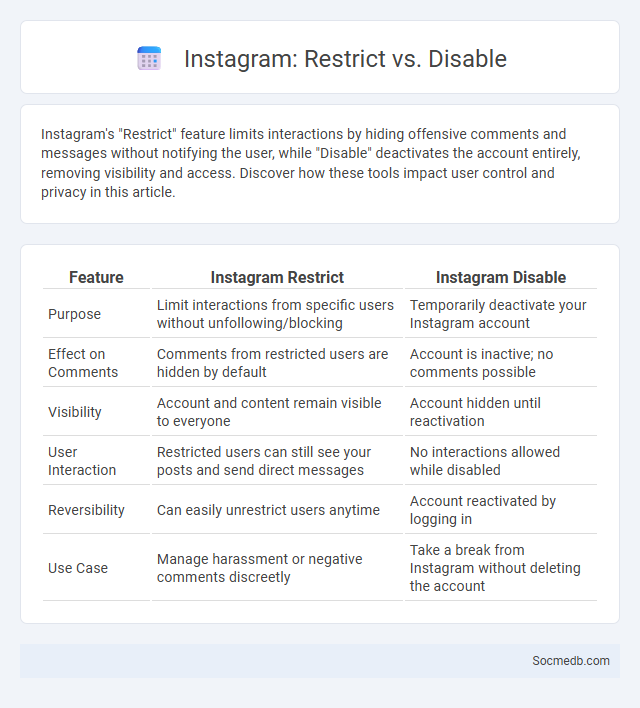
Photo illustration: Instagram Restrict vs Disable
Instagram's "Restrict" feature limits interactions by hiding offensive comments and messages without notifying the user, while "Disable" deactivates the account entirely, removing visibility and access. Discover how these tools impact user control and privacy in this article.
Table of Comparison
| Feature | Instagram Restrict | Instagram Disable |
|---|---|---|
| Purpose | Limit interactions from specific users without unfollowing/blocking | Temporarily deactivate your Instagram account |
| Effect on Comments | Comments from restricted users are hidden by default | Account is inactive; no comments possible |
| Visibility | Account and content remain visible to everyone | Account hidden until reactivation |
| User Interaction | Restricted users can still see your posts and send direct messages | No interactions allowed while disabled |
| Reversibility | Can easily unrestrict users anytime | Account reactivated by logging in |
| Use Case | Manage harassment or negative comments discreetly | Take a break from Instagram without deleting the account |
Understanding Instagram's Safety Features
Instagram's safety features include tools like account privacy settings, comment controls, and two-factor authentication to protect your personal information and manage interactions effectively. You can customize who sees your content, restrict or block users, and report inappropriate behavior to enhance your online experience. These features are designed to create a safer environment by empowering you with control over your privacy and security on the platform.
What Does "Restrict" Mean on Instagram?
On Instagram, "Restrict" is a privacy feature designed to limit unwanted interactions without blocking or unfollowing someone. When you restrict an account, comments from that person on your posts are only visible to them, and their direct messages are moved to your message requests without notifications. This tool helps users manage online harassment and maintain control over their social space discreetly.
How "Disable" Works on Instagram Accounts
Disabling your Instagram account temporarily hides your profile, photos, comments, and likes from other users without deleting the account permanently. When you disable your account, Instagram retains all your data, allowing you to reactivate it simply by logging back in. This feature is useful for taking a break from social media while ensuring your content and connections remain intact for when you return.
Key Differences: Restrict vs. Disable on Instagram
Restrict on Instagram limits interactions by hiding comments from a specific user and restricting their direct messages without notifying them, enhancing subtle control over unwanted engagement. Disable refers to temporarily or permanently deactivating the entire account, removing access and visibility from the platform until reactivated or permanently deleted. Restrict maintains user presence with limited interaction, while disable removes user activity completely.
When Should You Use "Restrict"?
You should use "Restrict" on social media when you want to limit interactions without blocking someone entirely, allowing you to control who can see or comment on your posts. This feature helps protect your privacy by hiding comments from specific users while still maintaining a minimal connection. Restrict is ideal for managing subtle online boundaries and preventing unwanted engagement without causing confrontation.
Situations for Disabling Your Instagram Account
Situations for disabling your Instagram account include the need for a temporary digital detox to improve mental health, concerns about privacy breaches or cyberbullying, and managing excessive screen time that interferes with productivity. Users might also disable their accounts during periods of personal transition or to prevent data overload while reevaluating their social media usage habits. Instagram provides an option for temporary deactivation, allowing account restoration with all data intact when the user decides to return.
Impacts on Privacy: Restrict vs. Disable
Restricting social media privacy settings limits data visibility to select audiences, reducing exposure without eliminating platform usage. Disabling accounts removes personal information entirely from the platform, offering stronger privacy protection but sacrificing connectivity and content access. Choosing between restriction and disabling depends on balancing privacy concerns with the desire to maintain an online presence.
How to Restrict or Disable Someone on Instagram
To restrict or disable someone on Instagram, navigate to their profile, tap the three-dot menu, and select "Restrict" to limit interactions without unfollowing or blocking. Restricting hides their comments from others and prevents them from seeing when you're active, while disabling access requires blocking them entirely. You control your Instagram experience by adjusting these privacy settings to ensure a safe and comfortable environment.
Pros and Cons: Restricting vs. Disabling Users
Restricting users on social media allows for maintaining community standards by limiting harmful content visibility without complete removal, thus preserving user engagement and offering a chance for behavior correction. Disabling users removes problematic accounts entirely, effectively stopping harmful activities but potentially reducing overall interaction and risking censorship concerns. Balancing these approaches requires analyzing impact on platform safety, user experience, and freedom of expression to optimize moderation strategies.
Choosing the Right Instagram Feature for Safety
Selecting the appropriate Instagram feature for safety involves leveraging tools like two-factor authentication, account privacy settings, and content controls to protect Your online presence. Utilizing Instagram's Close Friends list allows you to share stories with a trusted group, reducing exposure to unintended audiences. Regularly updating privacy settings and monitoring interactions enhances Your security and personal data protection on the platform.
 socmedb.com
socmedb.com